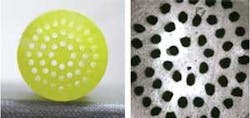BEAM COMBINING: Digital holography combines optical-fiber beams coherently
Tremendous strides have been made in increasing the output power of single-mode fiber lasers. Power increases can also be obtained by combining the output beams from several fiber lasers. To date, this has been achieved through wavelength beam combining (operating each fiber laser at a different wavelength and overlapping the beams with a dispersive element to sum their intensities in the far field), and through passive and active phase-locking techniques that involve phase detection and compensation of phase errors (see www.laserfocusworld.com/articles/332972).
A new alternative technique for coherent beam combining of the outputs from several fiber lasers or amplifiers has been developed at Thales Research and Technology (Palaiseau, France) that uses self-adaptive digital holography and eliminates the need for phase measurements or complex electronic feedback loops.1 This method is compatible with a large number of fibers, and is simply implemented with a CCD detector and a two-dimensional phase spatial light modulator (SLM).
The technique uses a two-dimensional array of fiber amplifiers, each collimated by a lens array with the parallel axis at its extremity. A low-power seeding plane wave propagates through the fiber array. The interference between the resulting segmented wavefront from the fibers and a reference plane wave are recorded on a CCD camera (see figure). For each fiber, the interference pattern consists of a series of linear fringes whose position is given by the relative dephasing between the fibers. As this dephasing evolves over time, the recorded fringes scroll on the CCD. The CCD camera signal is then used to drive a SLM that displays the recorded fringe pattern and acts as a dynamic digital-phase hologram. A new reference plane wave is then used to diffract on the SLM. On the -1 diffraction order, the phase-conjugated segmented wavefront from the fiber array is generated. By reinjecting this wavefront into the fibers, all the dephasing terms are compensated and the resulting output beams are phase locked. In this scheme, coherent combining is obtained by a process of conjugate wavefront generation.
Combining hundreds of fibers
Limitations in terms of the number of phase-lockable fibers are governed by the resolution of the main optoelectronic components in the system. To ensure good diffraction efficiency, the number of interference fringes per fiber should be about 10. In addition, the number of pixels per fringe for the detector should be about 10 to enable a phase precision of λ/10. Because CCD and CMOS detectors, as well as SLMs, have a high resolution (typically 1920 × 1080 pixels with a fill factor of 90%), it is possible to phase lock as many as 200 fibers in parallel with a phase-control precision of λ/10 and a bandwidth of 100 Hz. For higher-bandwidth correction up to a few kilohertz, a higher-speed camera and faster SLM are required.
An experimental proof-of-concept was demonstrated by the researchers for three single-mode polarization-maintaining passive fibers at 1.06 µm using a Nd:YAG laser with a 10 kHz bandwidth expanded to a collimated beam. The first beamsplitter creates a reference beam and feeds the fiber array. A second one separates the reference in two arms: one is used to record the hologram on the CCD, the other generates the conjugated segmented wavefront by diffracting through the SLM and is fed back to the fibers to phase lock the output beams for coherent combination.
The research team is currently working to demonstrate phase locking for a larger number of fibers. The team says that this concept has high potential for extending the performance of fiber lasers–in particular for the pulsed regime–and will be useful for applications such as light detection and ranging and free-space communications that require both high-energy and high-spatial/spectral-quality fiber sources.
REFERENCE
- C. Bellanger et al., Optics Letters 33, 24, p. 2937 (Dec. 15, 2008).
About the Author

Gail Overton
Senior Editor (2004-2020)
Gail has more than 30 years of engineering, marketing, product management, and editorial experience in the photonics and optical communications industry. Before joining the staff at Laser Focus World in 2004, she held many product management and product marketing roles in the fiber-optics industry, most notably at Hughes (El Segundo, CA), GTE Labs (Waltham, MA), Corning (Corning, NY), Photon Kinetics (Beaverton, OR), and Newport Corporation (Irvine, CA). During her marketing career, Gail published articles in WDM Solutions and Sensors magazine and traveled internationally to conduct product and sales training. Gail received her BS degree in physics, with an emphasis in optics, from San Diego State University in San Diego, CA in May 1986.
